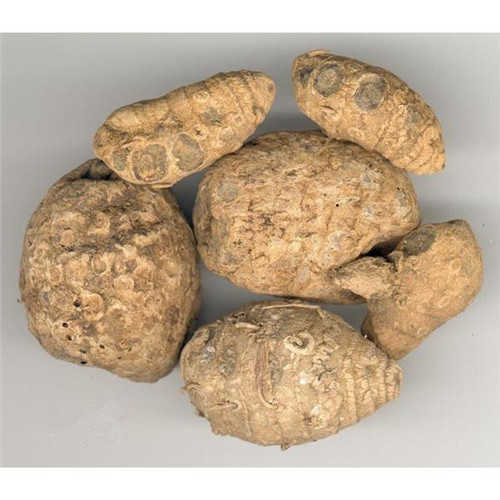Actually TCM wise it doesn't refer to the best known species like Curcuma longa or Curcuma zedoaria. Instead it means their cousin in the family Zingiberaceae – Curcuma phaeocaulis Val. or Curcuma aeruginosa Roxb., Curcuma Kwangsiensis S. G.Lee et C. F. Liang, and Curcuma wenyujin Y.H. Chen et C. Ling. As its name suggested, root is the main medicinal part. It comes with several common names like rhizoma curcumae, Turmeric Rhizome, and so on. But sometimes they are generally called as Zedoaria Rhizome, Zedoary, zedoary root, zedoary rhizome, and more. However, apparently they mean different species on particular occasions.
Curcuma phaeocaulis Val. is mainly produced in Sichuan, Guangdong, and Guangxi. Roots are oval, long oval, conical or fusiform, 2 to 8cm long, 1.5 to 4cm in diameter, and with tip blunt top and obtuse bottom. Surface is from greyish yellow to gray-brown, with raised upper part and rounded or slightly concave fibrous scar or residual fibrous roots. It is heavy, solid, and with grayish brown to blue-brown waxy section. It is lightly scented, and slightly bitter and acrid in flavor; Curcuma Kwangsiensis S. G.Lee et C. F. Liang is primarily from Guangxi. It comes with slightly raised rings and yellow-brown to brown cross section, which is often with light yellow powder and cortex with yellow-white ring pattern; C.wenyujin Y.H.Chenet C.Ling is basically from in Wenzhou, Zhejiang Province. It comes with yellowish brown to dark brown section, which is often with pale yellow to yellow-brown powder. It is scented or slightly scented.

Turmeric Root
WHITE TURMERIC ROOT BENEFITS
As mentioned above, the turmeric root health benefits have been found by ancient herbalists and widely used for various ailments thanks to its great healing properties. Nowadays it is also made into tea, powder, smoothie, juice, extract, supplement, essential oil, drink, curry, capsules, chutney, etc. for cooking and medical purposes. And it has an even more extensive applications on Acne, alzheimer's, acne scars, Arthritis, cancer, gynecomastia, Gout, detox, inflammation, pain, weight loss, skin problems, Diabetes, hair removal, and more.
PROVEN TURMERIC GINGER ROOT RELATED HERBAL FORMULAS
Herbalist of TCM (Traditional Chinese medicine) believes that this herb is acrid and bitter in flavor and warm in properties. And it covers meridians of liver and spleen. Its major functions are promoting the circulation of qi to break stasis and removing food retention to relieve pain. Prime turmeric root uses include cardiodynia, indigestion, abdominal distention and pain, amenorrhea due to stagnation of blood, dysmenorrhea, abdominal mass, bruises, early stage cervical cancer, and more. Recommended turmeric root dosage is from 3 to 10 grams.
1) E Zhu San
It comes from Shou Shi Bao Yuan (Protection of Vital Energy for Longevity). This is a formula mainly used for abdominal mass and abdominal pain due to Amenorrhea. Other major herbal ingredients include San Leng (rhizoma sparganii), Dong Quai (Dang Gui), Xiang Fu (Nut Grass Rhizome), and so on.
2) E Zhu Wan
This formula comes from Zheng Zhi Zhun Sheng (The Level-line of Patterns & Treatment). It is basically formulated for abdominal pain and bloating caused by dyspepsia. Other major herbs include Qing Pi (Green Tangerine Peel) and Bing Lang (Betel Nut).
3) E Zhu Kui Jian Tang
This is a prescription coming from Ji Yang Gang Mu (Compendium of Therapies for Men's Diseases). It is primarily designed for abdominal distension caused by accumulation inside. Rest vital herbs are Hong Hua (Safflower Flower), Sheng Ma (Black Cohosh Rhizome), Wu Zhu Yu (Evodia Fruit), Chai Hu (Bupleurum), and more.

![Diseases, Symptoms, tcm, [tcmwindow.com]](/uploadFile/adImg/2015/11/11/f5cbfcc0-4df5-4646-9b9a-f316651a0199.jpg)





